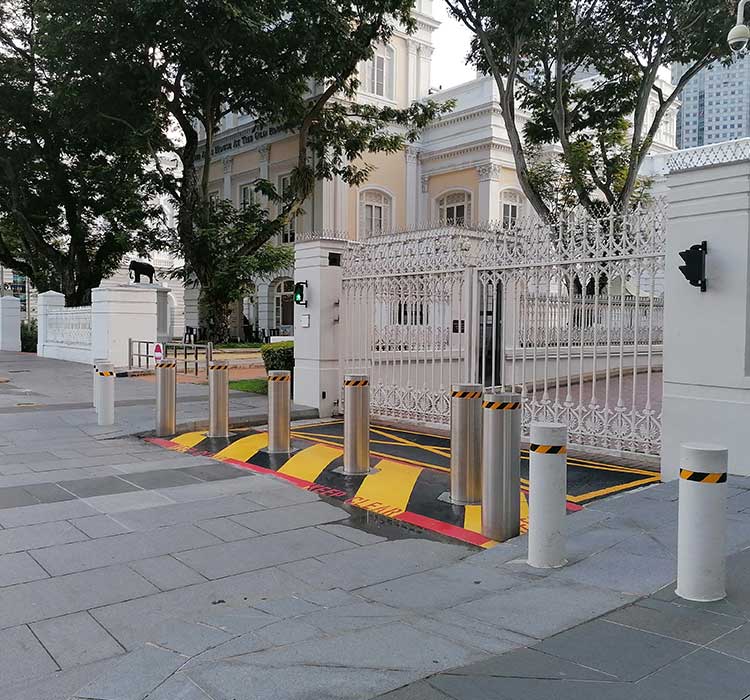The Impact of Bollards on Traffic Flow Optimization in Abu Dhabi and Dubai
Traffic congestion is a common issue in urban areas, and cities like Abu Dhabi and Dubai are no exception. With rapidly growing populations and increasing numbers of vehicles on the roads, optimizing traffic flow has become a significant challenge for these cities. One solution that has gained attention is the strategic placement of bollards. Bollards are sturdy posts installed along roadways, and their careful placement can have a significant impact on traffic management, reducing congestion, and improving overall transportation efficiency. This article explores the impact of bollards on traffic flow optimization in Abu Dhabi and Dubai.
Understanding Traffic Flow Optimization
Before delving into the role of bollards, it is essential to understand the concept of traffic flow optimization. Traffic flow optimization refers to the implementation of strategies and measures to ensure smooth and efficient movement of vehicles on the road network. It involves minimizing congestion, reducing travel times, and enhancing overall safety.
Challenges in Abu Dhabi and Dubai
Abu Dhabi and Dubai face unique challenges when it comes to traffic flow optimization. Both cities experience high volumes of vehicles, especially during peak hours and tourist seasons. The presence of numerous landmarks, business districts, and residential areas further adds to the complexity. Without effective traffic management strategies, these cities can suffer from severe congestion, leading to increased travel times, frustration among road users, and negative environmental impacts.
The Role of Bollards
Bollards play a crucial role in optimizing traffic flow in Abu Dhabi and Dubai. They offer several benefits that contribute to a more efficient transportation system.
Channeling Traffic
One of the primary functions of bollards is to channel traffic. By strategically placing bollards, traffic engineers can guide vehicles along desired routes and prevent drivers from making unauthorized turns or entering restricted areas. This helps maintain a smooth flow of traffic and reduces the risk of accidents caused by sudden lane changes or illegal maneuvers.
Separating Vehicle Types
In busy urban areas, it is common to have different types of vehicles, such as cars, buses, bicycles, and pedestrians, sharing the same roads. Bollards can be used to create physical barriers that separate these different modes of transportation. For example, dedicated bicycle lanes can be established by placing bollards along the sides of the road, ensuring the safety of cyclists and preventing conflicts with motorized vehicles. Similarly, bollards can be utilized to create pedestrian-only zones, improving safety and encouraging walking in crowded areas.
Controlling Access and Parking
Bollards are effective tools for controlling access to certain areas and managing parking. In Abu Dhabi and Dubai, where the availability of parking spaces is a significant concern, bollards can be used to designate specific parking zones and restrict unauthorized parking. By preventing illegal parking and ensuring a systematic allocation of parking spaces, bollards help reduce congestion caused by inefficient parking practices.
Case Studies in Abu Dhabi and Dubai
Several noteworthy case studies demonstrate the successful implementation of bollards to optimize traffic flow in Abu Dhabi and Dubai.
Sheikh Zayed Road, Dubai
Sheikh Zayed Road is one of the busiest highways in Dubai, connecting major commercial and residential areas. To alleviate congestion, bollards were strategically placed to create bus-only lanes. This initiative not only improved the speed and reliability of public transportation but also encouraged commuters to shift from private vehicles to buses, reducing overall traffic volume on the road.
Corniche Road, Abu Dhabi
Corniche Road in Abu Dhabi is a popular waterfront promenade, attracting both locals and tourists. By installing bollards along certain sections of the road, dedicated pedestrian areas were created, ensuring the safety and comfort of pedestrians. This not only enhanced the overall experience for pedestrians but also reduced conflicts with vehicles, leading to smoother traffic flow.
Future Considerations and Challenges
While bollards have shown promising results in optimizing traffic flow in Abu Dhabi and Dubai, there are a few considerations and challenges that need to be addressed for their continued effectiveness.
Integration with Smart Traffic Management Systems
To maximize the benefits of bollards, their integration with smart traffic management systems is crucial. These systems utilize sensors, cameras, and real-time data to monitor traffic conditions and adjust signal timings or lane assignments accordingly. By incorporating bollards into such systems, traffic engineers can have better control over the flow of vehicles and respond dynamically to changing traffic patterns.
Maintenance and Durability
Bollards, being physical structures, require regular maintenance and inspection to ensure their functionality and durability. Adequate measures should be taken to protect bollards from damage caused by accidents or vandalism. Additionally, routine inspections should be conducted to identify and address any issues promptly, such as damaged or bent bollards, which can affect their effectiveness in managing traffic flow.
Public Awareness and Education
To ensure the successful implementation and acceptance of bollards, public awareness and education campaigns are essential. Clear signage and communication about the purpose and benefits of bollards should be provided to help drivers and pedestrians understand the changes in road configurations. Additionally, public feedback and engagement should be encouraged to address any concerns or suggestions related to the placement and impact of bollards on traffic flow.
Conclusion
The strategic placement of bollards in Abu Dhabi and Dubai has demonstrated its significant impact on traffic flow optimization. These sturdy barriers effectively channel traffic, separate vehicle types, and enhance control over access and parking. The implementation of bollards has not only reduced congestion and improved safety but also contributed to overall transportation efficiency. As cities strive to create more sustainable and livable environments, bollards have proven to be valuable tools in managing traffic flow. To ensure their continued effectiveness, integration with smart traffic management systems, proper maintenance, and public awareness campaigns are essential. As the demand for bollards increases, partnering with a reliable security system supplier and bollard supplier becomes crucial for cities like Abu Dhabi and Dubai to enhance their traffic management strategies and create safer road networks.
